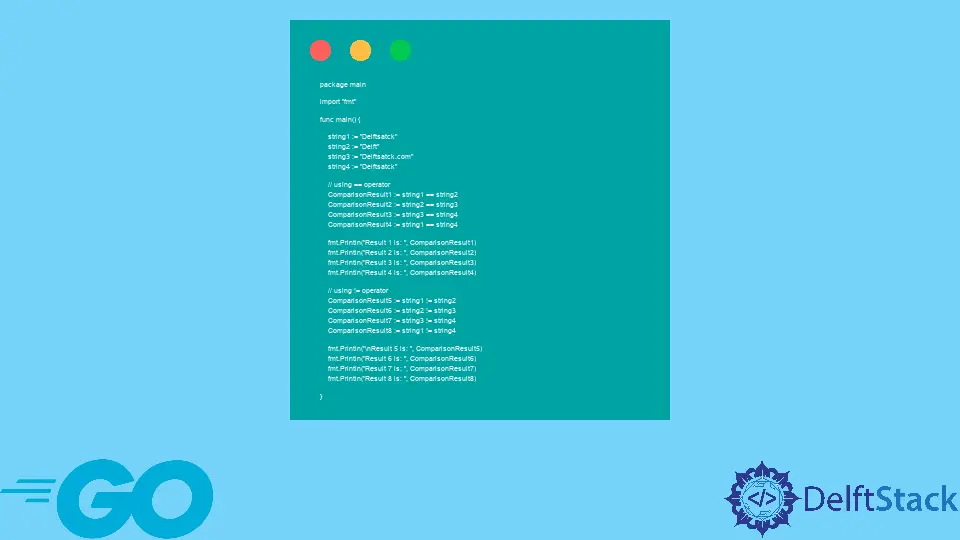How to Compare Strings in Go
- Use the
Compare()Method to Compare Strings in GoLang - Use Comparison Operators to Compare Strings in GoLang

This tutorial demonstrates how to compare strings in GoLang.
GoLang has two methods to compare strings: the built-in method Compare() and the other is a comparison by GoLang comparison operators. This tutorial demonstrates these two methods to compare strings in GoLang.
Use the Compare() Method to Compare Strings in GoLang
The built-in method Compare() in GoLang is used to compare two strings. This method uses the lexicographical order to compare two strings; the syntax for this method is:
func Compare(a, b string) int Where a and b are the two strings to be compared, it returns an integer value. There are three return types based on the comparison of strings.
- If a == b then
compare()method will return 0. - If a > b then
compare()method will return 1. - If a < b then
compare()method will return -1.
Let’s try an example to compare strings using the Compare() method.
package main import ( "fmt" "strings" ) func main() { var string1 = "x" var string2 = "y" var string3 = "Delftstack" var string4 = "Delftscope" // string1 < string2 should return -1 fmt.Println(strings.Compare(string1, string2)) // string2 > string1 should return 1 fmt.Println(strings.Compare(string2, string1)) // string1 == string1 should return 0 fmt.Println(strings.Compare(string1, string1)) // string3 > string4 should return 1 fmt.Println(strings.Compare(string3, string4)) // string4 < string3 should return -1 fmt.Println(strings.Compare(string4, string3)) // Let's create a condition string5 := "Hello this is delftstack.com!" string6 := "Hello this is DELFTSTACK.COM!" // using the Compare function if strings.Compare(string5, string6) == 0 { fmt.Println("The strings are a match.") } else { fmt.Println("The strings do not match.") } } The code above tries to compare strings using the Compare() method and returns the integers described above. The code also creates a condition based on the returned integer.
See the output:
-1 1 0 1 -1 The strings do not match. Use Comparison Operators to Compare Strings in GoLang
GoLang also supports the comparison operators as in other languages; these comparison operators include ==, !=, >=, <=, <, >. The == and != are used to check the equality of strings, and the other four are used to compare the strings in lexicographical order.
These comparison operators return Boolean operators, i.e., true and false. Let’s try an example first using the == and != operators.
package main import "fmt" func main() { string1 := "Delftsatck" string2 := "Delft" string3 := "Delftsatck.com" string4 := "Delftsatck" // using == operator ComparisonResult1 := string1 == string2 ComparisonResult2 := string2 == string3 ComparisonResult3 := string3 == string4 ComparisonResult4 := string1 == string4 fmt.Println("Result 1 is: ", ComparisonResult1) fmt.Println("Result 2 is: ", ComparisonResult2) fmt.Println("Result 3 is: ", ComparisonResult3) fmt.Println("Result 4 is: ", ComparisonResult4) // using != operator ComparisonResult5 := string1 != string2 ComparisonResult6 := string2 != string3 ComparisonResult7 := string3 != string4 ComparisonResult8 := string1 != string4 fmt.Println("\nResult 5 is: ", ComparisonResult5) fmt.Println("Result 6 is: ", ComparisonResult6) fmt.Println("Result 7 is: ", ComparisonResult7) fmt.Println("Result 8 is: ", ComparisonResult8) } The code above will compare the given strings based on equality and inequality. See the output:
Result 1 is: false Result 2 is: false Result 3 is: false Result 4 is: true Result 5 is: true Result 6 is: true Result 7 is: true Result 8 is: false Now let’s try an example using the >=, <=, <, > operators to compare strings by their lexicographical order. See example:
package main import "fmt" func main() { string1 := "Delftsatck" string2 := "Delft" string3 := "Delftsatck.com" string4 := "Delftsatck" // using < operator ComparisonResult1 := string1 < string2 ComparisonResult2 := string2 < string3 ComparisonResult3 := string3 < string4 ComparisonResult4 := string1 < string4 fmt.Println("Result 1 is: ", ComparisonResult1) fmt.Println("Result 2 is: ", ComparisonResult2) fmt.Println("Result 3 is: ", ComparisonResult3) fmt.Println("Result 4 is: ", ComparisonResult4) // using > operator ComparisonResult5 := string1 > string2 ComparisonResult6 := string2 > string3 ComparisonResult7 := string3 > string4 ComparisonResult8 := string1 > string4 fmt.Println("\nResult 5 is: ", ComparisonResult5) fmt.Println("Result 6 is: ", ComparisonResult6) fmt.Println("Result 7 is: ", ComparisonResult7) fmt.Println("Result 8 is: ", ComparisonResult8) // using >= operator ComparisonResult9 := string1 >= string2 ComparisonResult10 := string2 >= string3 ComparisonResult11 := string3 >= string4 ComparisonResult12 := string1 >= string4 fmt.Println("\nResult 9 is: ", ComparisonResult9) fmt.Println("Result 10 is: ", ComparisonResult10) fmt.Println("Result 11 is: ", ComparisonResult11) fmt.Println("Result 12 is: ", ComparisonResult12) // using <= operator ComparisonResult13 := string1 <= string2 ComparisonResult14 := string2 <= string3 ComparisonResult15 := string3 <= string4 ComparisonResult16 := string1 <= string4 fmt.Println("\nResult 13 is: ", ComparisonResult13) fmt.Println("Result 14 is: ", ComparisonResult14) fmt.Println("Result 15 is: ", ComparisonResult15) fmt.Println("Result 16 is: ", ComparisonResult16) } The above strings will now be compared based on the lexicographical order. See the output:
Result 1 is: false Result 2 is: true Result 3 is: false Result 4 is: false Result 5 is: true Result 6 is: false Result 7 is: true Result 8 is: false Result 9 is: true Result 10 is: false Result 11 is: true Result 12 is: true Result 13 is: false Result 14 is: true Result 15 is: false Result 16 is: true Sheeraz is a Doctorate fellow in Computer Science at Northwestern Polytechnical University, Xian, China. He has 7 years of Software Development experience in AI, Web, Database, and Desktop technologies. He writes tutorials in Java, PHP, Python, GoLang, R, etc., to help beginners learn the field of Computer Science.
LinkedIn Facebook